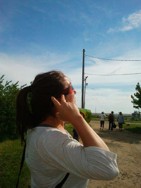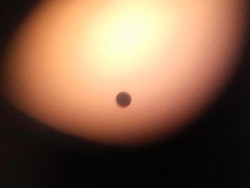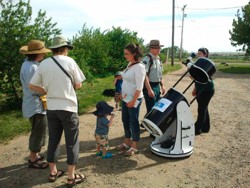The 2012 June 5-6 transit of Venus (ToV) is over, and there won't be another one till 2117! Many RASC members successfully viewed the ToV here and abroad, and you can find the graphic record of the observations―and of the astronomers making them―here.
Note: all images are copyright of the attributed photographers and graphic artists, and must not be used without prior permission
|
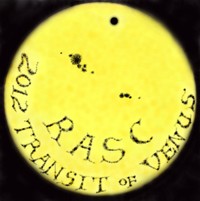 |
Elias Williams, Regina Centre
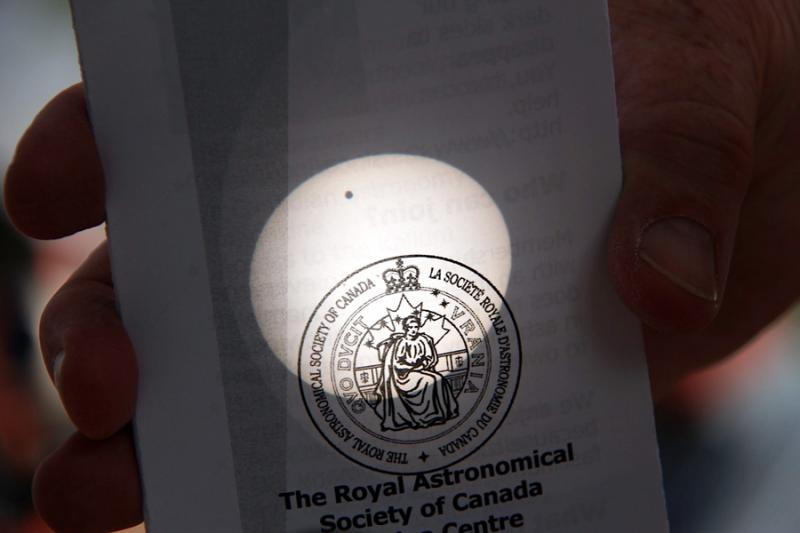
James Edgar, Regina Centre
|
The observing site was Yorkton, SK, at the home of Jim and Shirley Huziak. We entertained 25 guests (26, if one counts the neighbour's curious & friendly dog). This site featured good food, drink, and better weather than forecast. The PST was a great hit.
More of James' images can be seen here.
|
||
Kathleen Houston, Saskatoon Centre
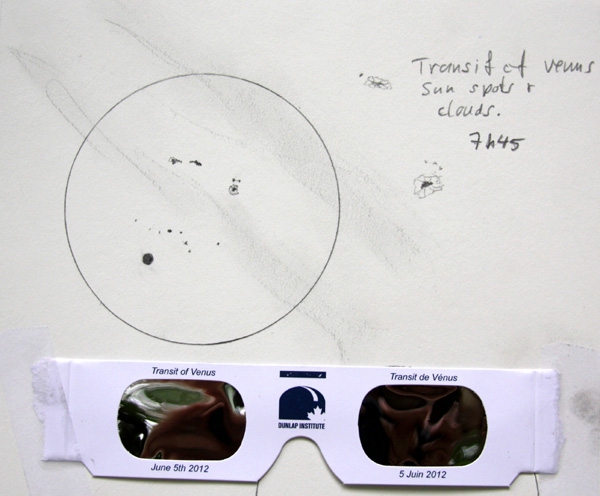
Madeline and Peter Hagar, Regina Centre
Tim Ceaser
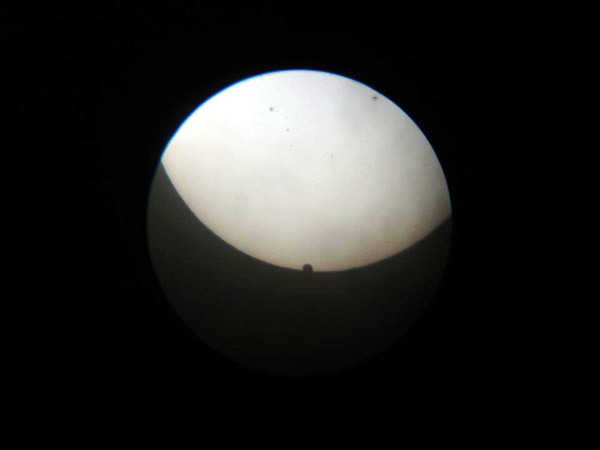 |
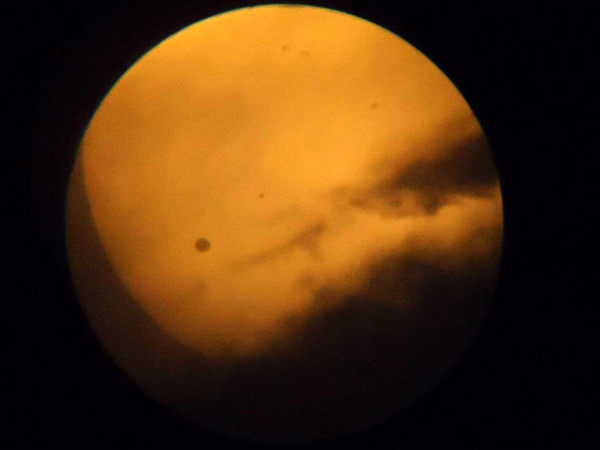 |
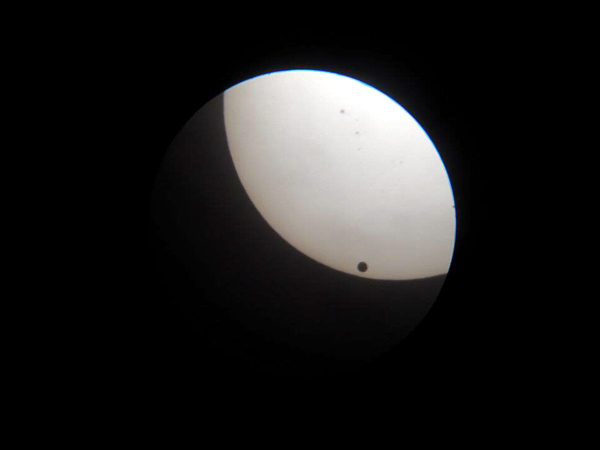 |
|
I took these images observing from the top of mount carmel, which is a (relatively) large hill in Saskatchewan. It was extremely windy and very difficult to get any pictures. To take the images I held my digital camera up to the eyepiece - a difficult task made much more difficult by the wind almost tipping the telescope and me over. However I got some pics, so in the end I was happy.
More of Tim's images can be found here.
|
||
R.A. Rosenfeld, RASC Archivist
The Archivist writes:
“I observed the transit from southern Saskatchewan, and lived to tell the tale!” – would look good on a t-shirt, but it does describe my ToV experience.
I had agreed to go out to Canada’s west from Toronto to observe the ToV because the window for observation would be longer than in the east, and an invitation from the Regina Centre of the Royal Astronomical Society of Canada to deliver a ToV lecture at the Regina Science Centre would nicely cover the expenses.
The appointed meteorologist for our ToV équipe, Chris Beckett, was obsessive about the weather – as any astronomical expedition meteorologist ought to be. He was fully prepared to drag us 400 km in pursuit of clear skies on the day of the ToV, come Hell or high water (curiously enough, both the landscape of Hell, and much high water can be encountered in Saskatchewan with its fourteen major drainage basins, the world’s biggest Møns Klint glaciotectonic hills, and the world’s largest active sand dunes).Chris’ favoured potential ToV observing site featured the following amenities:
- wood ticks
- black widow spiders
- rattlesnakes
- inviting quicksand pockets
- cheerfully undomesticated packs of Coyotes
- friendly lone Grey wolves
- wolverines with attitude
- BIG steely-eyed irate Bison
- ghost towns, isolated graves, and smiley bleached skulls of indeterminate species
- authentic locals with guns but little patience
- relics of Capone
- remote location far from succour
- and the clearest (and at night darkest) skies one could wish for
According to the weather data Chris had constantly feeding into his MAC, on the day before the ToV his favoured site was forecast to have good to very good weather for the event. We went out that night to a much closer observing location to test some of our equipment (but obviously not the full-aperture solar filters and Herschel wedges), and when I remarked on the “interesting” animal noises, he said: “Ah, the coyotes. Don’t worry. They’re small, almost like domestic dogs – well, except that they’re not domestic. I’ll tell you what; pay no attention to them till you hear them crunching the detritus underfoot, then you’ll know they’re close, and have surrounded the observing site. Still don’t worry, just run fast for the car. We can collect the gear in the morning.”
Transit morning things had changed dramatically weather wise. According to satellite imagery a weather system coming up from Montana and s t r e t c h i n g far to the south but heading north was going to make his preferred site not so preferable. Regina, in fact right outside where I’d lectured earlier in the week, was looking better. We did a couple of early morning press interviews for the ToV from the site, which gave us the chance to check the sight lines to the west, and available wind shelter. And this indeed became our transit station.
When we set up at about 15:30 CST there were still clouds obscuring the Sun, but in the 10 minutes or so before 1st contact they cleared – one is almost tempted to say miraculously cleared – and we were able to see 1st and 2nd contact clearly, including the black drop and aureole effects. We also did some education and public outreach, but only after we’d done our critical observations – as did John Winthrop in 1761, showing his hosts the ToV in the observing lulls, as it were.
What of the experimental archaeology of the ToV? We did manage to run several experiments, the chief of which was to answer the question “with how small an aperture (O.G.) can the aureole effect be observed?”. Our experiment was qualified by the equipment available. We sought to employ 18th-century OTAs with doublet and singlet objectives, and single-element eyepieces, alongside Short-style Gregorians. Likely instruments were located, but unfortunately permission could not be obtained to use them for the experiment. The experiment was altered to use modern hand-made high-quality doublet refractors, several of the 80 mm O.G. class, and one 125 mm O.G. OTA. We had prepared simple aperture stops for the latter, and our preliminary result is that we could discern the aureole intermittently in the period embracing 1st and 2nd contact with a 50.8 mm O.G. of f/14.56, a surprisingly modest system. We are presently writing up the results for publication. By way of a very preliminary conclusion we can venture to say that if an 18th-century observer was viewing the ToV through the best quality doublet or triplet of the day, and using the on-axis area of best definition and least aberrations, it is possible that a system as modest as 50.8 mm O.G. of f/14.56 would have sufficed for the aureole. In the nature of such experiments it is important to state that no stronger or more robust conclusion is possible.
As it turned out I did get attacked by one of the dangerous creatures of the wilderness listed above. Fortunately that didn’t happen during the ToV. I’ve mostly recovered…
The results of Chris', Randall's, Mike O'Brien's, Jeff Danielson's & Ron Sheppard's experiment made it into the pages of Bob Crease's column in Physics World!
- Log in to post comments

